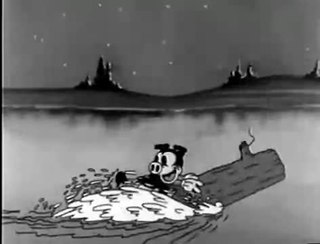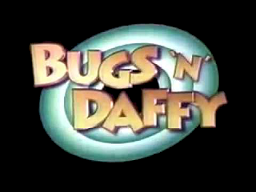
Looney Tunes is an American animated franchise produced and distributed by Warner Bros. It began as a series of short films that originally ran from 1930 to 1969, concurrently with its partner series Merrie Melodies, during the golden age of American animation. Following a revival in the late 1970s, new shorts were released as recently as 2014. The two series introduced a large cast of characters, including Bugs Bunny, Daffy Duck, and Porky Pig. The term Looney Tunes has since been expanded to also refer to the characters themselves.

Merrie Melodies is an American animated comedy short film series distributed by Warner Bros. Pictures. It is the companion series to Looney Tunes, and featured many of the same characters as the former series. It originally ran from August 2, 1931, to September 20, 1969, during the golden age of American animation, though it had been revived in 1979, with new shorts sporadically released until June 13, 1997. Originally, Merrie Melodies placed emphasis on one-shot color films in comparison to the black and white Looney Tunes films. After Bugs Bunny became the breakout character of Merrie Melodies and Looney Tunes transitioned to color production in the early 1940s, the two series gradually lost their distinctions and shorts were assigned to each series randomly.

The Censored Eleven is a group of Looney Tunes and Merrie Melodies cartoons originally produced and released by Warner Bros. that have been withheld from syndication in the United States by United Artists (UA) since 1968. UA owned the distribution rights to the Associated Artists Productions library at that time, and decided to pull these 11 cartoons from broadcast because the use of ethnic stereotypes in the cartoons, specifically African stereotypes, was deemed too offensive for contemporary audiences. The ban has been continued by UA and the successive owners of the pre-August 1948 Looney Tunes/Merrie Melodies. Since 1968, these shorts have not been officially broadcast on television and have only been exhibited theatrically by Warner Bros. once since their withdrawal. They have turned up, however, on low-cost VHS and DVD collections.
DePatie–Freleng Enterprises was an American animation studio founded by former Warner Bros. Cartoons employees in May 1963, before dissolving in 1981. Based in Burbank, California, DFE produced animation for film and television.
Turner Entertainment Company is an American multimedia company founded by Ted Turner on August 2, 1986. Purchased by Time Warner on October 10, 1996 as part of its acquisition of Turner Broadcasting System (TBS), the company was largely responsible for overseeing the TBS library for worldwide distribution. In recent years, this role has largely been limited to being the copyright holder, as it has become an in-name-only subsidiary of Warner Bros., which currently administers their library.

Famous Studios was the first animation division of the film studio Paramount Pictures from 1942 to 1967. Famous was founded as a successor company to Fleischer Studios, after Paramount seized control of the aforementioned studio after the departure of its founders, Max and Dave Fleischer, in 1942. The studio's productions included three series started by the Fleischers—Popeye the Sailor, Superman, and Screen Songs—as well as Little Audrey, Little Lulu, Casper the Friendly Ghost, Honey Halfwitch, Herman and Katnip, Baby Huey, and the anthology Noveltoons series.

Warner Bros. Animation Inc. is an American animation studio which is part of the Warner Bros. Television Studios, a division of Warner Bros., which is a subsidiary of Warner Bros. Discovery and serves as the animation division and label of Warner Bros.

Warner Bros. Television Studios is an American television production and distribution studio of the Warner Bros. Television Group division of Warner Bros.. Since 2006, it is one of the two companies that serve as television production arms of The CW, alongside Paramount Global's subsidiary CBS Studios; it also serves as a television production arm of DC Comics and distribution arm of HBO, Cartoon Network and Adult Swim. Warner Bros. Television Studios has also produced shows for other networks such as Blindspot & Found on NBC, Person of Interest on CBS, The Cleaning Lady on FOX, Abbott Elementary on ABC, It has also produced series for streaming services, including The Sandman on Netflix, Ted Lasso on Apple TV+, The Peripheral on Amazon Prime Video and Mrs. Davis on Peacock.

Noveltoons is a series of cartoons produced by Paramount Pictures' Famous Studios from 1943 to the end of the studio during 1967. The series was known for bringing the characters from Harvey Comics to life, such as Casper the Friendly Ghost, Wendy the Good Little Witch, Herman and Katnip, Little Audrey, and Baby Huey. All shorts from Baby Huey and Little Audrey are included. It was the successor to the series Color Classics produced by Fleischer Studios. Several Noveltoons feature characters which originated in Color Classics. This series was also similar to the two series from Warner Bros., Looney Tunes and Merrie Melodies, in that it features several recurring characters with one general title.
Warner Bros. Cartoons, Inc. was an American animation studio, serving as the in-house animation division of Warner Bros. during the Golden Age of American animation. One of the most successful animation studios in American media history, it was primarily responsible for the Looney Tunes and Merrie Melodies series of animated short films. The characters featured in these cartoons, including Bugs Bunny, Daffy Duck, and Porky Pig, are among the most famous and recognizable characters in the world. Many of the creative staff members at the studio, including directors and animators such as Chuck Jones, Friz Freleng, Robert McKimson, Tex Avery, Robert Clampett, Arthur Davis, and Frank Tashlin, are considered major figures in the art and history of traditional animation.
United Artists Television (UATV) was an American television production/distribution studio of United Artists Corporation that was formed on January 1, 1958. The company is remembered for producing series such as This Man Dawson, World of Giants, Stoney Burke, The Outer Limits, Gilligan's Island, My Mother the Car, The Fugitive, The Rat Patrol, thirtysomething, The New Phil Silvers Show, The Patty Duke Show and The Pink Panther Show. In September 2014, the studio briefly returned to full-time TV production under the new management of United Artists Media Group (UAMG), led in part by husband and wife producers Mark Burnett and Roma Downey. With its folding back into MGM Television, UATV was temporarily dormant until 2020 when MGM Television was reincorporated.
Hop, Look and Listen is a 1948 Warner Bros. Looney Tunes cartoon directed by Robert McKimson. The short was released on April 17, 1948, and stars Sylvester and Hippety Hopper, in the latter's first appearance.

The Wabbit Who Came to Supper is a 1942 Merrie Melodies cartoon featuring Bugs Bunny and Elmer Fudd. It was released on March 28, 1942, and directed by Friz Freleng.

Popeye the Sailor is an American animated series of short films based on the Popeye comic strip character created by E. C. Segar. In 1933, Max and Dave Fleischer's Fleischer Studios, based in New York City, adapted Segar's characters into a series of theatrical cartoon shorts for Paramount Pictures. The plotlines in the animated cartoons tended to be simpler than those presented in the comic strips, and the characters slightly different. A villain, usually Bluto, makes a move on Popeye's "sweetie", Olive Oyl. The villain clobbers Popeye until he eats spinach, giving him superhuman strength. Thus empowered, Popeye makes short work of the villain.
Warner Bros.' library of Oscar-nominated cartoons were showcased in a DVD set released by Warner Home Video on February 12, 2008 that included their own Looney Tunes and Merrie Melodies, as well as Tom and Jerry, Droopy, and other classic MGM cartoons, together with entries from Max Fleischer's Popeye and Superman series. All cartoons selected for this release were nominated for the Academy Award for Best Animated Short Film, with the exception of the film So Much for So Little, which won the Academy Award for Documentary Short Subject. A total of 41 cartoons were chosen for this set, 15 of them being Oscar winners.
TBS and TNT, the first two cable television networks in the Turner Broadcasting System, aired children's programming for a period of over 20 years, beginning in the 1970s and continuing through 1998.
Eliot Hyman (1904–1980) was an American film executive who helped co-found Seven Arts Productions.

Bugs 'n' Daffy is an American animated anthology television series that aired on The WB from 1995 to 1998 as part of their Kids' WB weekday lineup. The series featured cartoons from Warner Bros.' library of Looney Tunes and Merrie Melodies shorts. A weekly companion series, The Daffy Duck Show aired on Saturday mornings from 1996 to 1997.










